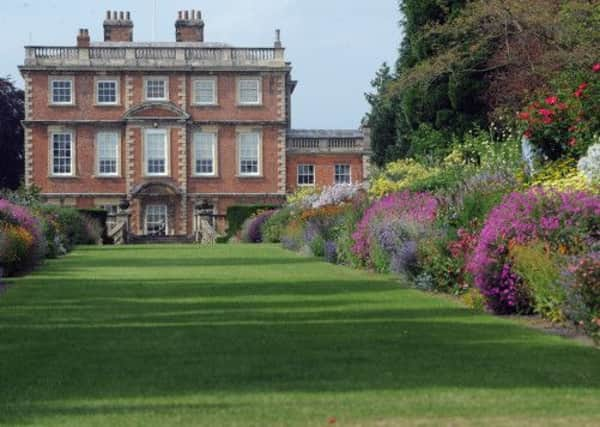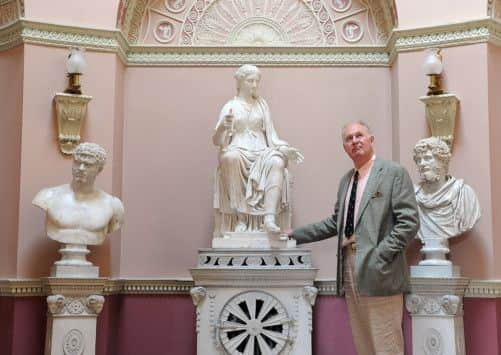The home guard


Richard Compton remembers his grandfather, Major Edward Compton, being such a hands-on chatelain that he would get stuck in, using his white hanky to wave the visitors into their parking spot.
When not arranging cars tidily the Major could often be seen working at the plant stall, talking to the punters about what might suit their gardens at home and selling them some of the same species that made his property so famous and popular with garden lovers from as far afield as the US and Australia.
Advertisement
Hide AdAdvertisement
Hide AdThe Compton family have lived at Newby Hall near Boroughbridge in North Yorkshire since 1748, when the estate was bought for Richard Compton’s ancestor William Weddell through an uncle’s legacy.


Weddell was a man of great taste and discernment and a prominent member of the Society of Dilettanti, a group of educated and aristocratic young men with a passionate interest in the art, architecture and culture of the ancient Romans and Greeks.
He was determined to turn Newby into a fitting setting for the fabulous artefacts collected on his travels, and soon Robert Adam was involved in remodelling the 17th-century building.
Adam’s greatest creation at Newby is a statuary gallery with central rotunda in the style of a Roman house. John Carr of York would later reorientate and remodel the east front of the house and add the north and south wings.
Advertisement
Hide AdAdvertisement
Hide AdThe house and estate (now 6,500 acres) passed down through forebears called Robinson and Vyner before reaching Major Edward Compton, who inherited in 1921, then Robert (Robin) Compton and now Richard, who came into the house and estate in 1997.
Richard and his wife Lucinda, a furniture restorer, and three children call the north wing of Newby Hall their home. It has none of the immense grandeur of a Castle Howard or Harewood House; its style is Georgian elegance on a human scale – and it’s chock full of treasures.
The visitors’ book reveals many a comment along the lines of “I can imagine myself living here...” from fans who’ve fallen for the nine Gobelins tapestries, the Chippendale furniture, William Weddell’s curious collection of chamber pots and the stunning array of classical statues and busts.
They marvel too at the contrasts between the various different areas of garden that cover 25 acres and meld into a coherent whole – from Sylvia’s Garden (described by one prominent horticulturalist as “like opening a woman’s knicker drawer”) to the world-renowned Cornus collection, the Rock Garden and the focal point of the famous herbaceous borders that burst with colour that almost hurts the eye.
Advertisement
Hide AdAdvertisement
Hide AdChildren let off steam in an adventure play area and special low-level fountains, and visiting Zimbabwean artists ply their trade in the Sculpture Walk.
The rest of the estate comprises a mixture of arable and livestock tenanted farms or farms run between the estate and farming partners, woodland, part of the River Ure, cottages, a church, light industrial units and commercial office space, plus a cafe, gift shop, plant stall, farm shop and miniature railway.
Of the 140,000 visitors a year 80 per cent come to explore the gardens, so the seven gardening staff work flat-out to maintain and improve what’s on offer. There are 60 full-time equivalent staff between the house and estate, including guides.
As with other beautiful houses in private hands, what is spent has to be earned.
Advertisement
Hide AdAdvertisement
Hide AdIn the six months when Newby is closed to the public, during which chandeliers are lowered to be cleaned carefully with soft toothbrushes and cornices are vacuumed, some parts of the house are still busy with corporate events and private functions.
There are around 14 weddings a year, and the flat but picturesque terrain makes the estate popular for charity runs and triathlons. Most of its earning capacity lies outdoors.
“Would we want 100,000 through the doors of the house? Probably not,” says estate manager Stuart Gill. “Its size and the sheer quantity of treasures concentrated in that space mean it could not stand the wear and tear, and costs of maintenance would be too high, to be honest.”
He adds, enigmatically, that the team at Newby are developing plans to “increase the outdoor offer...” For now he’s saying no more.
Advertisement
Hide AdAdvertisement
Hide AdAfter seeing its second busiest year since Newby opened to the public in 1948, 2011 and 2012 were scuppered by the weather, says Richard Compton. The crucial fixture of the Heritage Vehicle Rally, which brings in 4-5,000 visitors in late July, had to be cancelled because of relentless rain last summer.
“We suffered a thumping loss of 23 per cent,” says Compton, who is president of the Historic Houses Association, which represents 1,500 houses, castles and palaces across the UK. This year so far has seen a 28 per cent improvement on the same period in 2012.
One saving grace was that the management at Newby Hall and Gardens had tackled the recession head-on three years ago by halving the cost of season tickets to £22 for adults and £12 for children. This led to a five-fold increase in sales.
But there were still redundancies and reductions in hours for casual staff. Big cuts in projects like restoration of stonework were necessary, too.
Advertisement
Hide AdAdvertisement
Hide AdCompton describes the Government as “not very helpful” to privately-owned properties like Newby Hall in the economic crisis, while English Heritage was recently given £50m towards maintenance costs across its properties.
He says the HHA is in discussion with the Government about receiving some help. Privately held heritage properties pay taxes that others don’t, he says, yet all contribute to the prosperity of the country.
“Every £4 spent at a visitor attraction means a further £96 spend in the local area, so such attractions are a huge magnet for economic growth. And in a rural area like this, it’s important that we offer employment which keeps people here rather than having to move away.
“Research shows that 68 per cent of people who visit the UK from abroad say that its castles, palaces, houses and gardens are a reason for coming. The state of our heritage properties contributes greatly to how Britain is perceived overseas, and foreign visitors notice quickly if we are not in good shape.”
Advertisement
Hide AdAdvertisement
Hide AdThe cost of infrastructure work at a privately owned property can often mean selling off assets, and in 2003 Compton had to send to auction a heavily restored marble Roman statue of Venus.
It raised for £7.5m and the money funded the renovation of the Grade I listed stable block into high-end office accommodation for commercial rental.
Eco-friendly and money-saving hydro-electric and water management schemes are in hand at Newby Hall, but expensive conservation of artefacts can’t be skimped on – for example a precious 1770s carpet has just returned from year-long repairs in Turkey.
Following a fire risk assessment it was considered best to remove the original tacks which held the Gobelins tapestries in place over their (Chippendale) frames. The tapestries were considered the biggest priority to save in case of fire, and so the tacks are being replaced with Velcro, so they can be ripped from the frames in emergency.
Advertisement
Hide AdAdvertisement
Hide AdDave “the train” Driffield has been train driver and engineer at Newby for the past nine years. Driving up to 1,000 passengers a day in a miniature Class 52 Western train behind a Warrior class loco on a 13-minute ride through one and a half miles of glorious parkland beats his last job hands down, he says.
Mind you, before he worked in the potato-packing depot at Morrisons. Now he is the slim controller all year long, maintaining the track and trains during winter months too.
“I can honestly say I feel 100 per cent job satisfaction,” says Dave. “It’s especially great to give rides to many of the same families over the years. The railway’s for kids of all ages, and the other day we had five generations of the same family on board, celebrating the great-grandmother’s 92nd birthday. I love that.”
Mark Jackson, head gardener at the estate, suggested to Richard and Lucinda Compton a while ago that they should think about overhauling the renowned double herbaceous border, the glorious centrepiece of the gardens and one of the longest such borders in Europe at 140 metres long and four metres wide on either side of a central path.
Advertisement
Hide AdAdvertisement
Hide AdThey agreed and made careful decisions about changes that included banishing strong oranges and yellows and beefing up the rest of the spectrum.
Looking at the soft architecture of the borders, the eye is transfixed by a riot of delphiniums, campanula, lysimachia, salvia, geraniums, veronicastrum, eupatorium... in what is a classic country house style – only more so.
The plans, which will involve gradually emptying and re-filling segments over successive autumn seasons, have critics, who fear history is being erased.
But, when we visit, Lucinda Compton and Jackson are down on their knees among the borders, poring over a detailed diagram of the proposals. He acknowledges that to change such a beloved feature is to court some waspish responses.
Advertisement
Hide AdAdvertisement
Hide Ad“It would have been very easy for me to keep my head below the parapet. But by overhauling it we’ll take it forward and make it as successful and its impact as great for another 20 to 30 years.
“The border was starting to break down in the sense of its cohesiveness, the quality of plant associations, and the fact that we’ve been losing plants because some others have grown too vigorously.
“It’s exciting and a bit scary. I realise I am opening up myself, the team and the family to criticism, but overall we aim to retain the border’s uncontrived individuality, integrity, fullness and balance.”
Jackson says he and his staff like to interact with visitors and encourage gardening.
Advertisement
Hide AdAdvertisement
Hide Ad“Our message is always that there is nothing ‘fancy’ here. It’s a good, well laid-out working garden, and all the things people see here they can do at home.
“I also think it’s good for them to see that we have issues just like them, and they’ll spot the odd plant that we’ve lost. And just like them we wrestle with bindweed, mare’s tail and ground elder.”
www.newbyhall.com